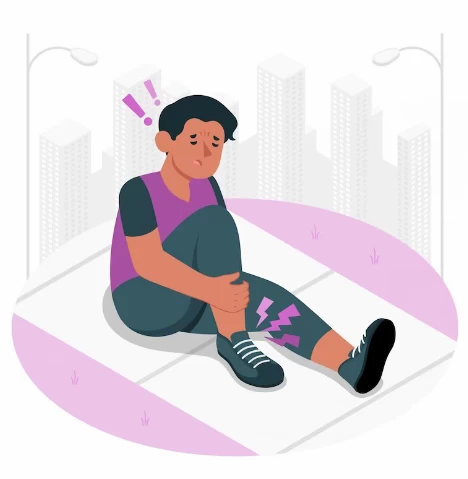
Physiotherapy Applications for Ankle Sprains
- Physiotherapy Applications for Ankle Sprains
- What is an Ankle Sprain?
- What Are the Physiotherapy Applications for Ankle Sprains?
- What Precautions Should Be Taken After Physiotherapy Applications for Ankle Sprains?
What is an Ankle Sprain?
An ankle sprain is an injury that occurs when the ankle is twisted beyond its normal range of motion. The ankle is a joint that supports the body's weight and enables movement. This joint is composed of three main bones: the talus (ankle bone), the tibia (shinbone), and the fibula (calf bone).
Ankle sprains typically occur during the following activities:
- Sudden twisting of the ankle outward (lateral sprain) or inward (medial sprain)
- Incorrectly landing on the foot due to balance loss or a fall
- Sports activities involving sudden movements, jumping, or pivoting
Symptoms of an ankle sprain may include:
- Severe pain and tenderness
- Swelling and bruising
- Restricted or difficult ankle movement
- Feeling of instability or difficulty standing
Ankle sprains are often classified into grades. Grade 1 sprains are characterized by mild stretching or straining and typically heal with rest and treatment. Grade 2 sprains involve partial tearing of the ligaments and may require further treatment. Grade 3 sprains result in complete ligament tears and may require serious treatment, including surgical intervention.
In case of an ankle sprain, it is important to consult a doctor or physiotherapist.
Accurate diagnosis and appropriate treatment can accelerate the healing process and reduce the risk of complications. Physiotherapy can play a significant role in the treatment of ankle sprains and expedite the recovery process.

What Are the Physiotherapy Applications for Ankle Sprains?
Here are the physiotherapy applications for ankle sprains:
- Rest and ice therapy: Initially, it is important to rest the affected area and apply ice. Ice helps reduce swelling and alleviate pain.
- Compression: Compression is recommended for ankle sprains. Applying gentle pressure using an elastic bandage or a specialized compression wrap can help control swelling.
- Elevation: Keeping the injured area elevated is advised. This can help reduce swelling and speed up the healing process.
- Mobilization exercises: Your physiotherapist may recommend specific exercises to increase your range of motion and regain ankle joint strength after an ankle sprain. These exercises can help strengthen muscles, improve flexibility, and enhance coordination.
- Balance exercises: Regaining balance ability is important after an ankle sprain. Your physiotherapist may suggest balance exercises using special equipment like a balance board. These exercises improve ankle stability and help prevent re-injury.
- Massage and manual therapy: Your physiotherapist may use massage or manual therapy techniques after an ankle sprain. These techniques can help reduce muscle spasms, improve circulation, and support healing.
- Ultrasound and electrotherapy: In some cases, your physiotherapist may employ modalities such as ultrasound or electrotherapy. These techniques can assist in pain reduction, promote tissue healing, and support the rehabilitation process.
The physiotherapy program is tailored to the severity of the ankle sprain, individual circumstances, and the pace of recovery. Consulting a specialist is important to achieve the best results.
What Precautions Should Be Taken After Physiotherapy Applications for Ankle Sprains?
Here are some precautions to be taken after physiotherapy applications for ankle sprains:
- Follow the expert's instructions: Regularly perform the exercises recommended by your physiotherapist and adhere to the treatment plan. Following the prescribed program will support your recovery process.
- Progress slowly: Avoid overexertion and sudden movements during the recovery process. Start exercises slowly and gradually increase your range of motion. Allow time for rest and relaxation.
- Wear supportive footwear: Use supportive shoes or ankle braces recommended by your physiotherapist. This will increase ankle stability and prevent re-injury.
- Be cautious during activities: It is important to avoid high-risk activities during ankle sprain recovery. Specifically, refrain from activities like fast running, jumping, or pivoting. When returning to physical activity, be cautious and take care to protect your ankle.
- Continue cold applications: To control swelling and pain during the healing process, you can continue using cold applications. Apply ice packs to the affected area as instructed by your physiotherapist.
- Rest and relax: Allowing sufficient time for healing is important after an ankle sprain. Avoid excessive strenuous activities and give your ankle the necessary time to recover.
- Stay committed to treatment: Physiotherapy for ankle sprains often takes time. Regularly follow the program recommended by your physiotherapist and attend treatment sessions as scheduled. This is important for achieving full recovery.
- Take preventive measures to avoid re-injury: To prevent re-injury after an ankle sprain, take preventive measures. For example, wear appropriate footwear, be cautious on slippery surfaces, and use ankle support taping or bracing during sports activities."




